Make your dinner extra special by serving this delicious Korean beef stew. This dish, locally known as “Galbi Jjim,” offers the family a taste of the bold flavors of Korea that can make for an exhilarating culinary experience.
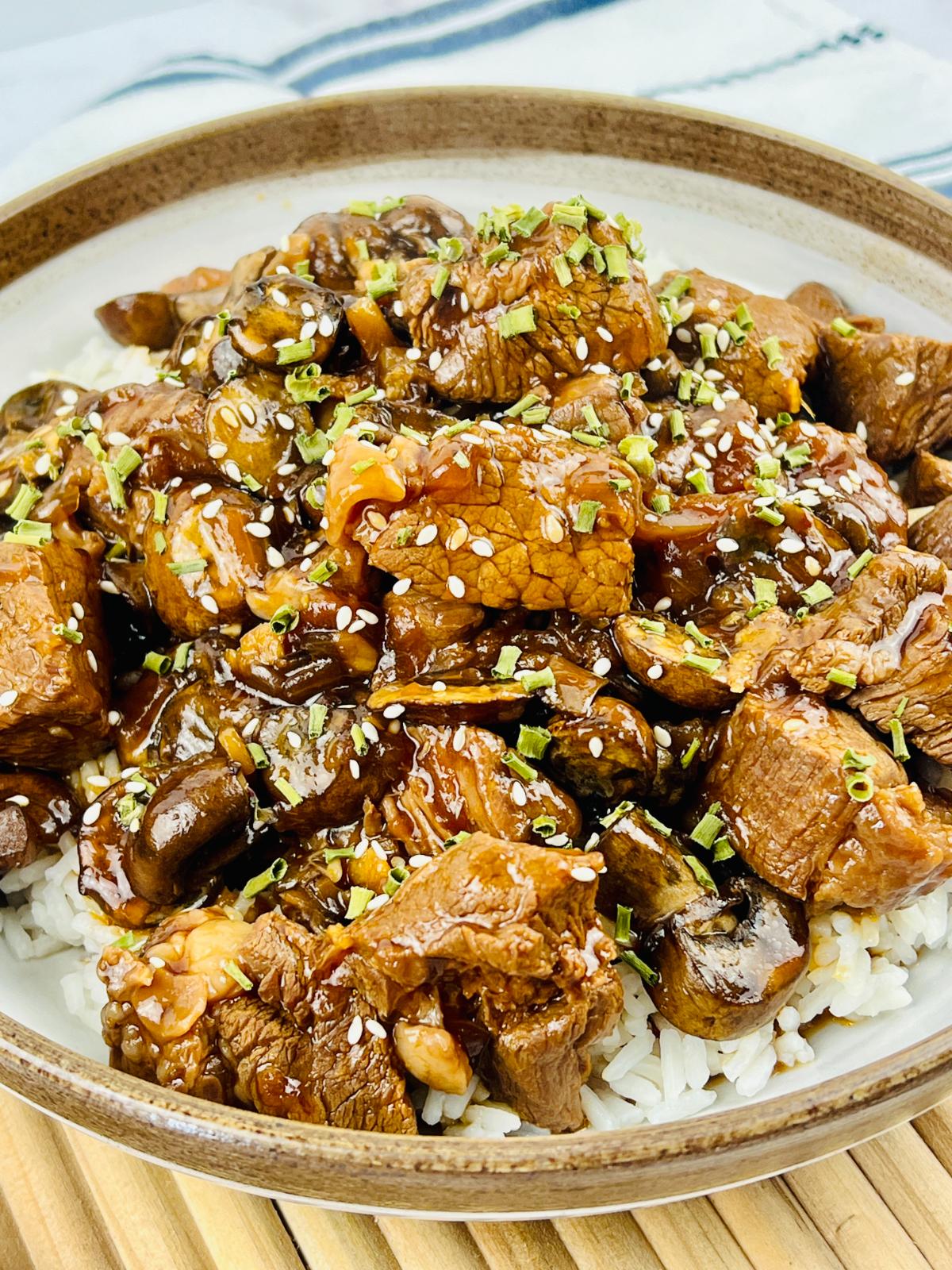
Serve it with Instant Pot plain rice or Instant Pot rice pilaf for a filling and satisfying meal that’s full of flavor. Or go all-out by offering classic side dishes like kimchi, japchae, or spicy cucumber salad alongside these braised beef short ribs.
Traditional Korean food is fantastic, like this Instant Pot Korean short beef ribs, because it’s often full of umami and a delicious hint of spiciness. You’ll find that and much more when you follow the recipe for making this beef stew recipe for dinner.
Jump to:
What is Korean Beef Stew Made of?
Korean beef stew, or many refer to it as Korean braised short ribs, is typically made using ingredients such as gochujang or spicy chili paste, Korean soy sauce, rice wine, garlic, and sesame oil. Combining these ingredients and the slow-cooking process gives this stew a rich and deeply satisfying flavor.
A good thing to note is that, aside from being delicious, Korean dishes are generally considered healthy. This is because they’re often made without using a lot of oil and can be packed full of vegetables, too.
This holds true for this beef stew. While you can make it without vegetables, adding some, like Korean radish, potatoes, or mushrooms, can help boost its nutritional content.
Plus, beef is considered a good source of protein, so adding stew to your family menu can be an excellent dietary choice.
SAVE THIS RECIPE!
Enter your email below and I’ll send it straight to your inbox.
❤️ Why You’ll Love This Recipe
If you’re still on the fence about making this dish, here are some reasons that might convince you to give this great recipe a try:
- Offers an explosion of flavors: Savory, sweet and mildly spicy, this Korean beef stew will blow you away with its flavors. You’ll definitely enjoy a tasty dinner with this dish on the table.
- Makes a perfect Korean bowl: You can serve this as a stew or create awesome Korean beef bowls for the family. You can do this by putting the beef stew on top of scooped rice with some tasty mushrooms or bean sprouts as toppings.
- Leftovers make for a tasty lunch: Save some leftovers and savor this dish again later in the week. It may even taste better that way.
- One-pot cooking: You will do most of the cooking in one pot. Put everything in the pot, leave it and just come back to it after a set time.
Looking for more beef recipes you can try? This list of Instant Pot beef recipes is sure to give you a wide variety of options to make.
🥘 Ingredients
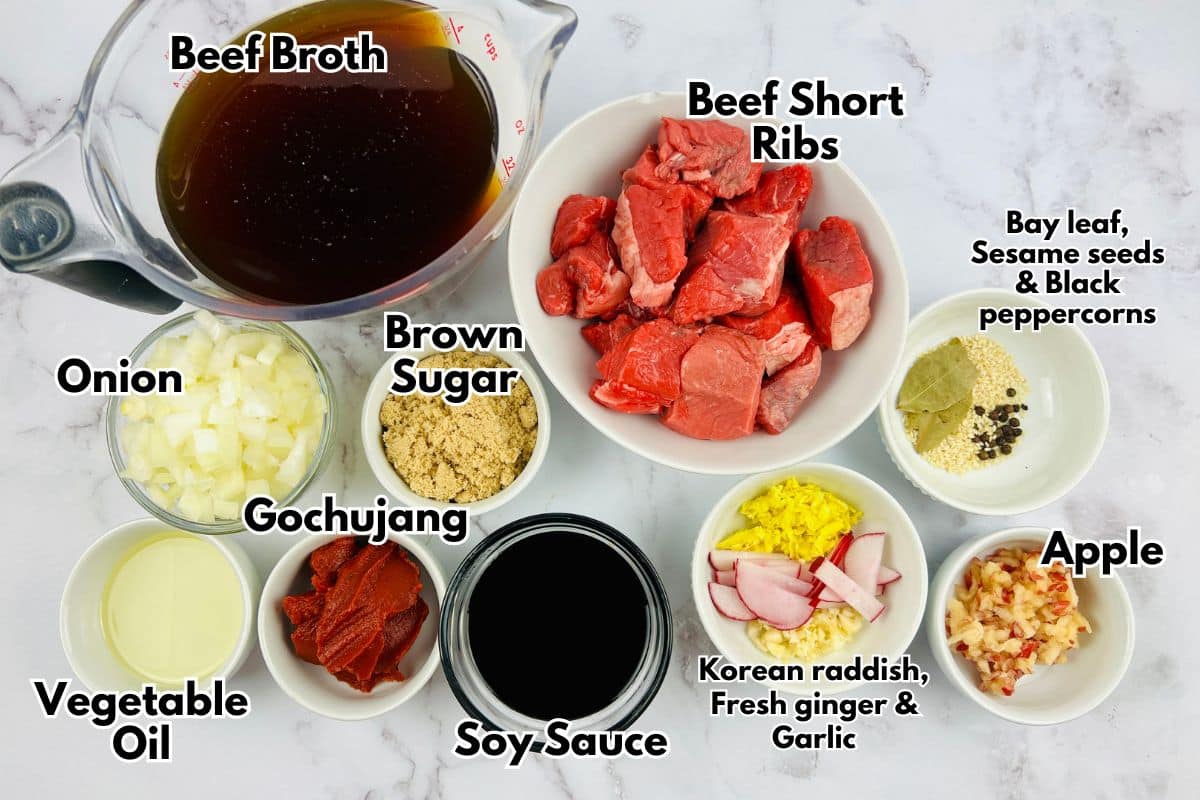
Here are some of the ingredients that you will need to create this delicious Asian dish:
- Beef short ribs: You can use bone-in or boneless beef short ribs for this recipe. Beef chuck roast can also work.
- Gochujang or spicy chili paste: This ingredient is fantastic to add to many meals like marinades and dipping sauces. To stews, it can add a deep umami flavor that makes them so hearty and delicious to eat.
- Brown sugar: It gives a good amount of sweetness to this dish.
- Korean pear: The enzymes in the pear help tenderize the meat and add a subtle sweetness.
See recipe card for complete list of ingredients and quantities.
🔀 Substitutions
Do you find yourself out of any of the necessary ingredients? Check out the following alternatives for making this short ribs recipe:
- Beef short ribs: If you’re out of beef short ribs or you want to try making this dish using a different meat, you can try using pork or chicken. You may need to adjust the cooking time, however.
- Gochujang: If you don’t have this red chili paste in your pantry, you may try making a substitute paste. Do this by mixing red chili pepper flakes, sugar and soy sauce and using it in place of gochujang,
- Korean pear or apple: You can use grated onion or honey instead.
- Fresh garlic and/or ginger: Use the powdered versions if you’re out of fresh ones.
- Brown sugar: Either white sugar or honey can be used to give this dish its sweetness.
- Beef stock: Using vegetable or chicken stock will work instead of beef broth.
🌈 Variations / Options / Add-Ins
Here are some ways to make this beef stew recipe even more fabulous:
- Kick the spice up a notch: You can adjust the amount of gochujang based on preference or tolerance. Start with 1/4 cup and add more to taste. You can add chili pepper flakes or jalapeno peppers for added heat.
- Cook it in the oven: If preferred, you can cook this dish in the oven. Preheat the oven to 325 F. Then, once all the ingredients have been added to the pot, instead of simmering the stew, you can cook it in the oven for about two to three hours until the meat becomes fork-tender.
- Add vegetables: Sweet potatoes, mushrooms, potatoes and carrots are good additions to this dish. If desired, add green leafy veggies like bok choy or celery.
- Make the stew thicker: You can add some cornstarch to the mix if you love a thick stew.
- Add mirin or rice wine: This adds a touch of sweetness to balance the savory and salty flavors. Mirin is a sweet rice wine commonly used in Korean cooking.
Another family-favorite Korean dish that perfectly blends beef with vegetables is this Korean ground beef and broccoli recipe. Give it a try if you love Korean food like we do.
🥄 Equipment Needed / Helpful Tools
Here are the tools you will need to use to make this delicious Korean beef stew:
- Dutch oven: You can use this or a heavy-bottom pot to make Korean beef stew.
- Mixing bowl: You will use this bowl for both making the marinade and marinating the beef.
🔪 How to Make Korean Beef Stew
Here is the step-by-step process of making Korean beef stew. Making the recipe might take some time, but the results will surely be worth the effort.
Step 1: Prep the Beef
Pat the beef dry with paper towels. If using bone-in short ribs, cut them into bite-sized pieces.
Step 2: Prepare the Marinade
To make the marinade, add the grated pear/apple (if using), soy sauce, gochujang, brown sugar, garlic, ginger and onion in a large bowl.
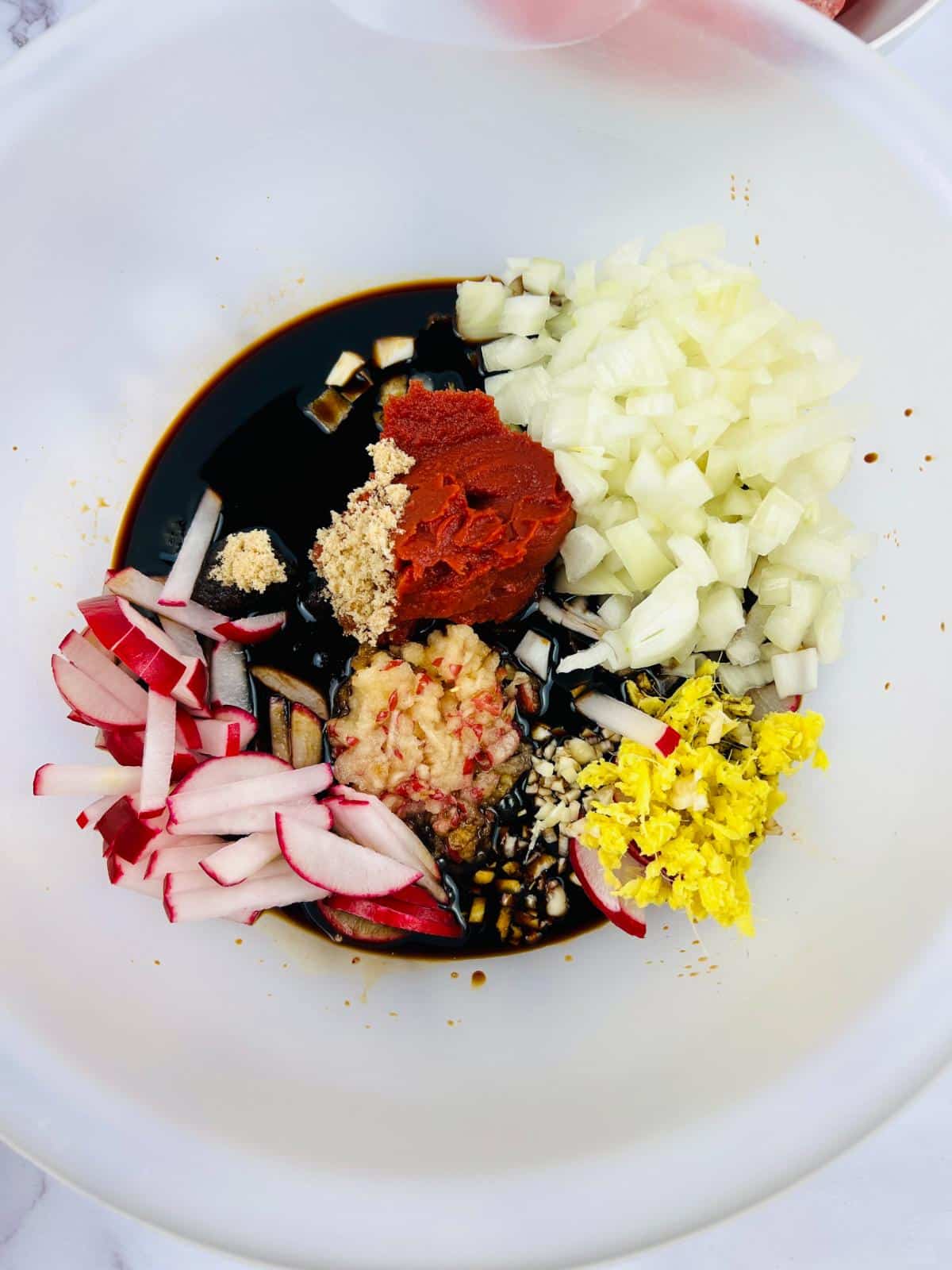
Step 3: Mix the Ingredients
Next, mix all the ingredients well.
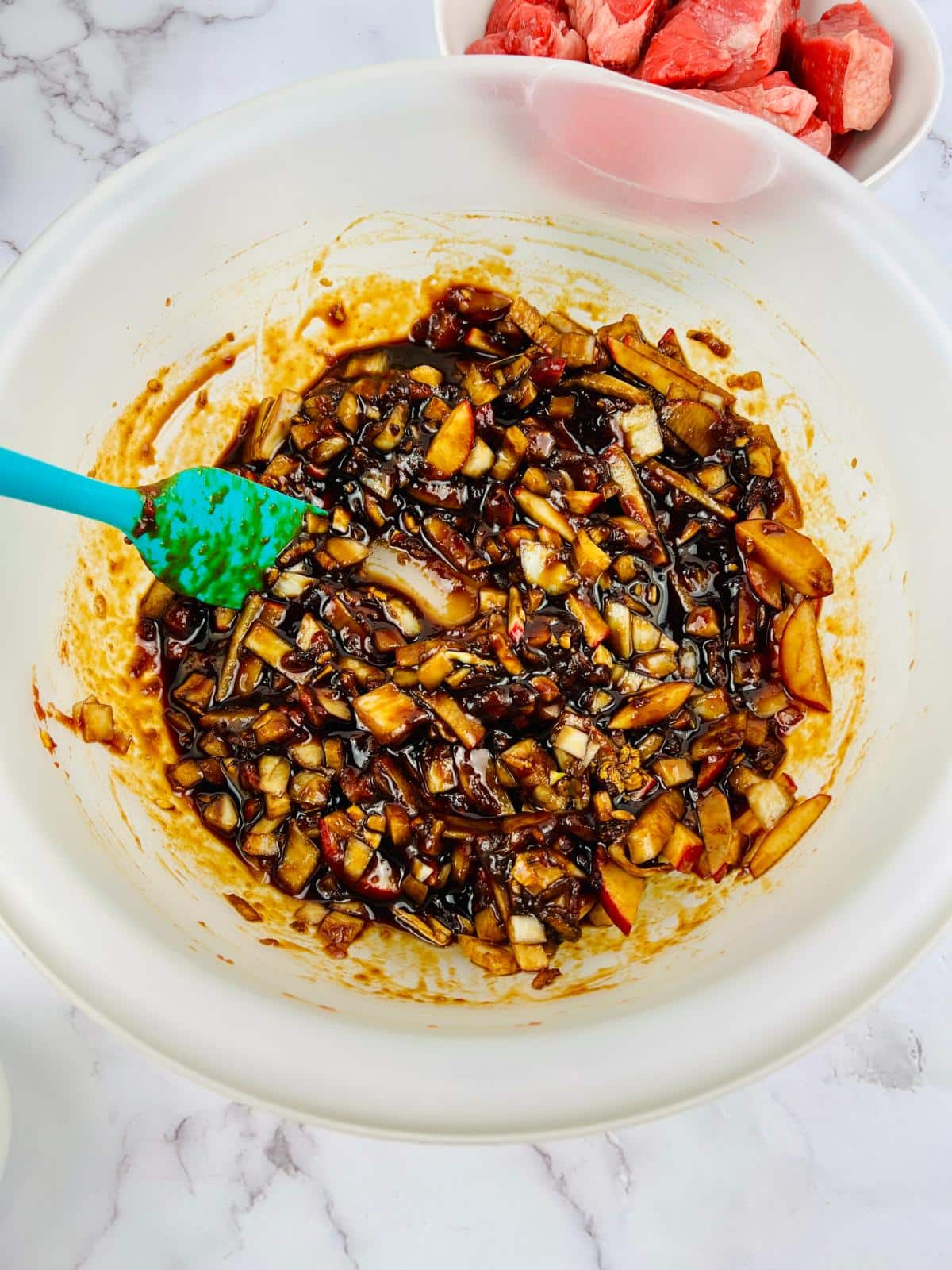
Step 4: Add the Beef
Add the beef to the bowl with the marinade.
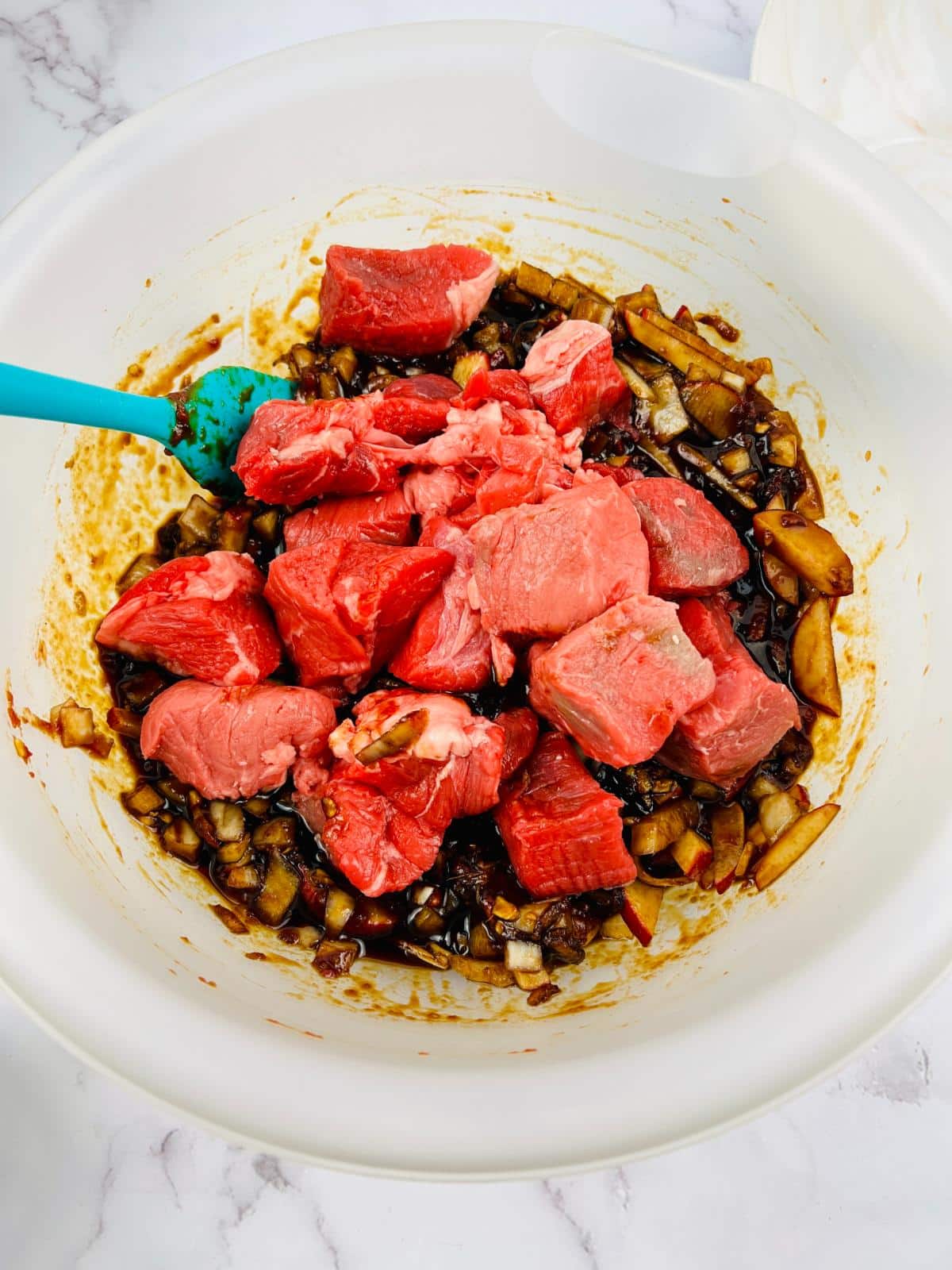
Step 5: Mix Them Well
Then, mix the beef with the marinade. Marinate for at least 30 minutes or up to overnight to infuse the beef with deeper flavors.
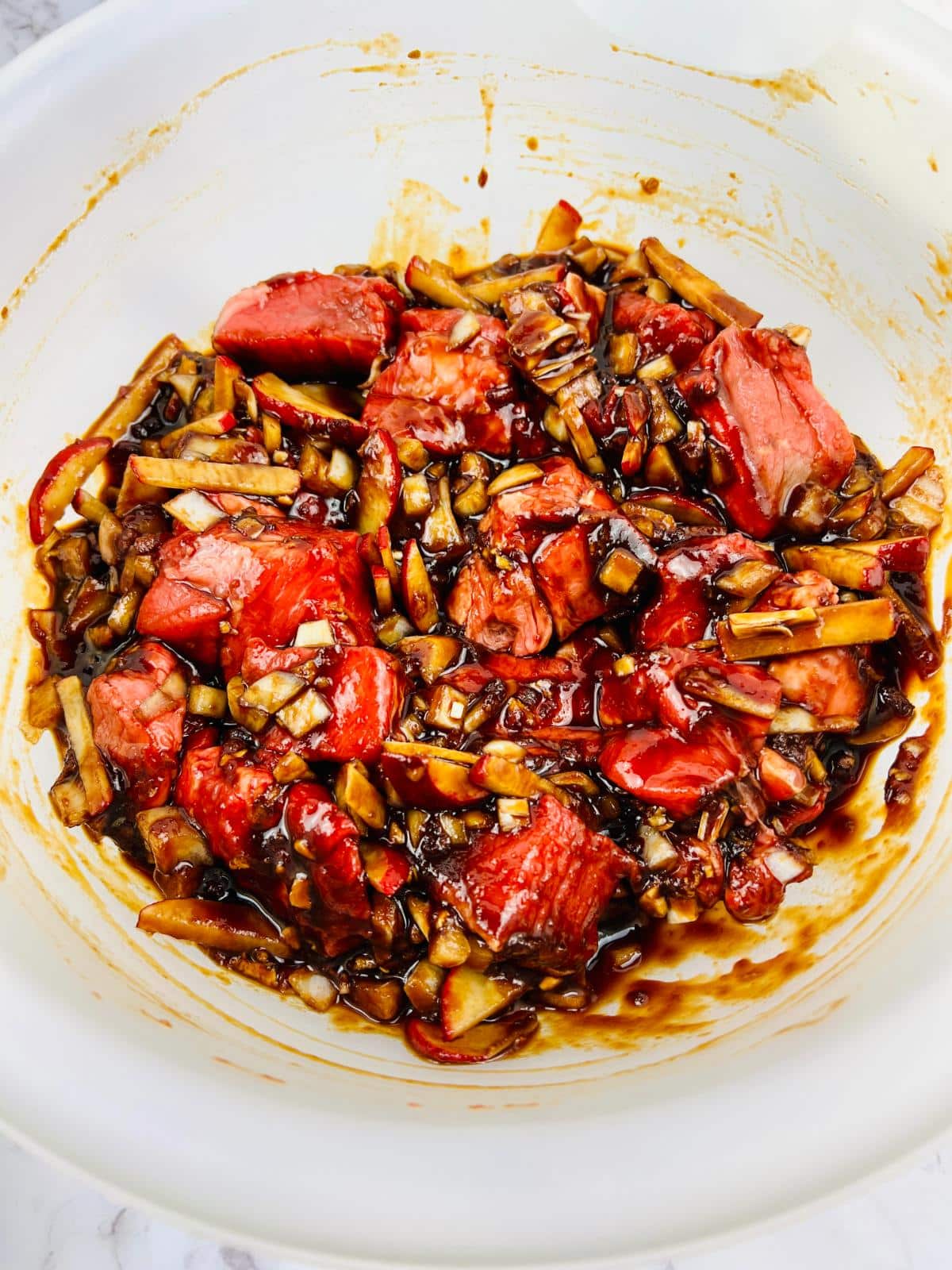
Step 6: Cook the Beef
Heat the vegetable oil in a large Dutch oven or heavy-bottomed pot over medium heat. Then, take the marinated beef and sear it in batches. Set aside.
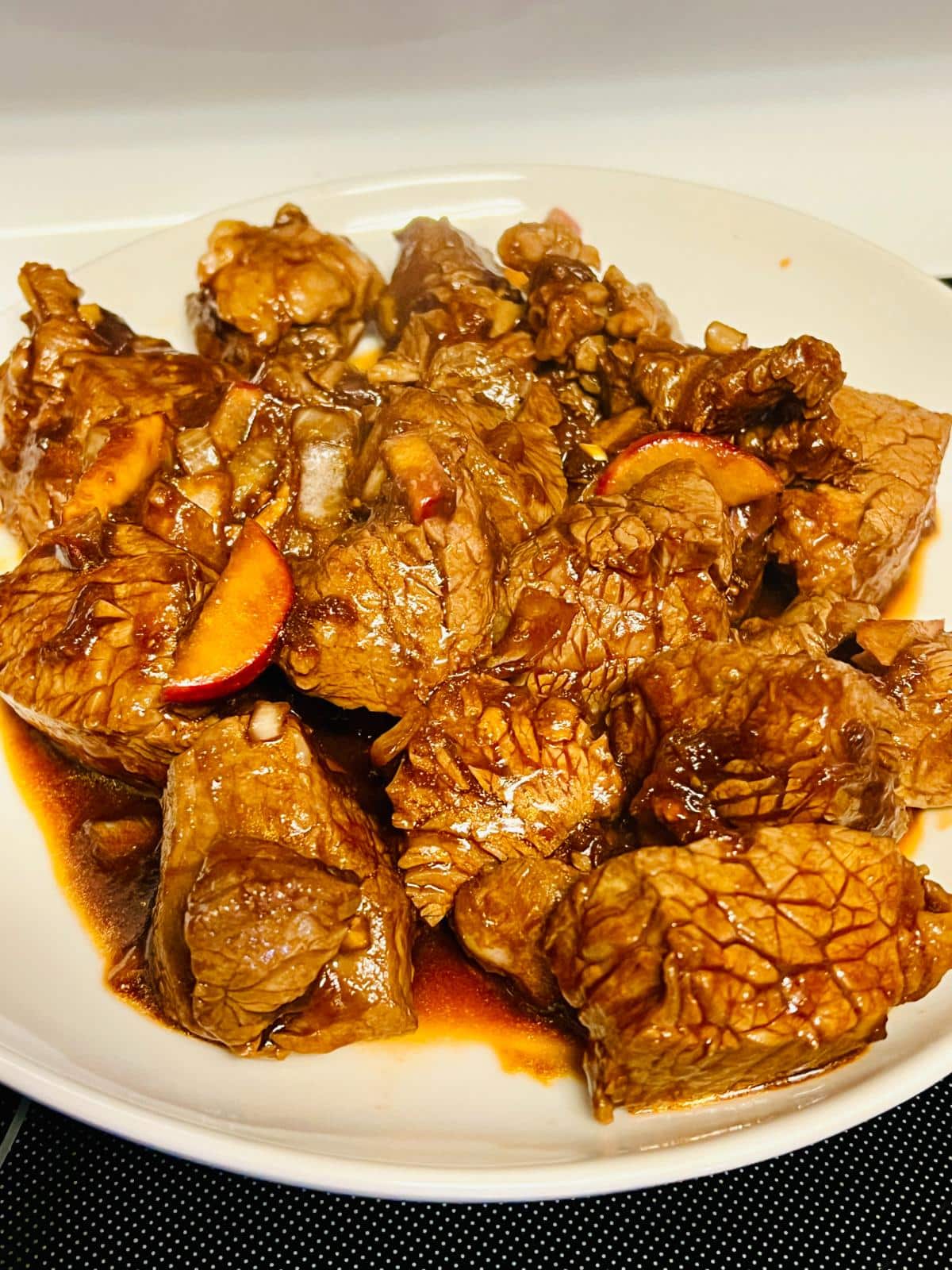
Step 7: Make the Broth
In the same pot, combine the beef broth, water, toasted sesame seeds, black peppercorns and bay leaf. Bring the broth to a boil, then reduce heat to simmer.
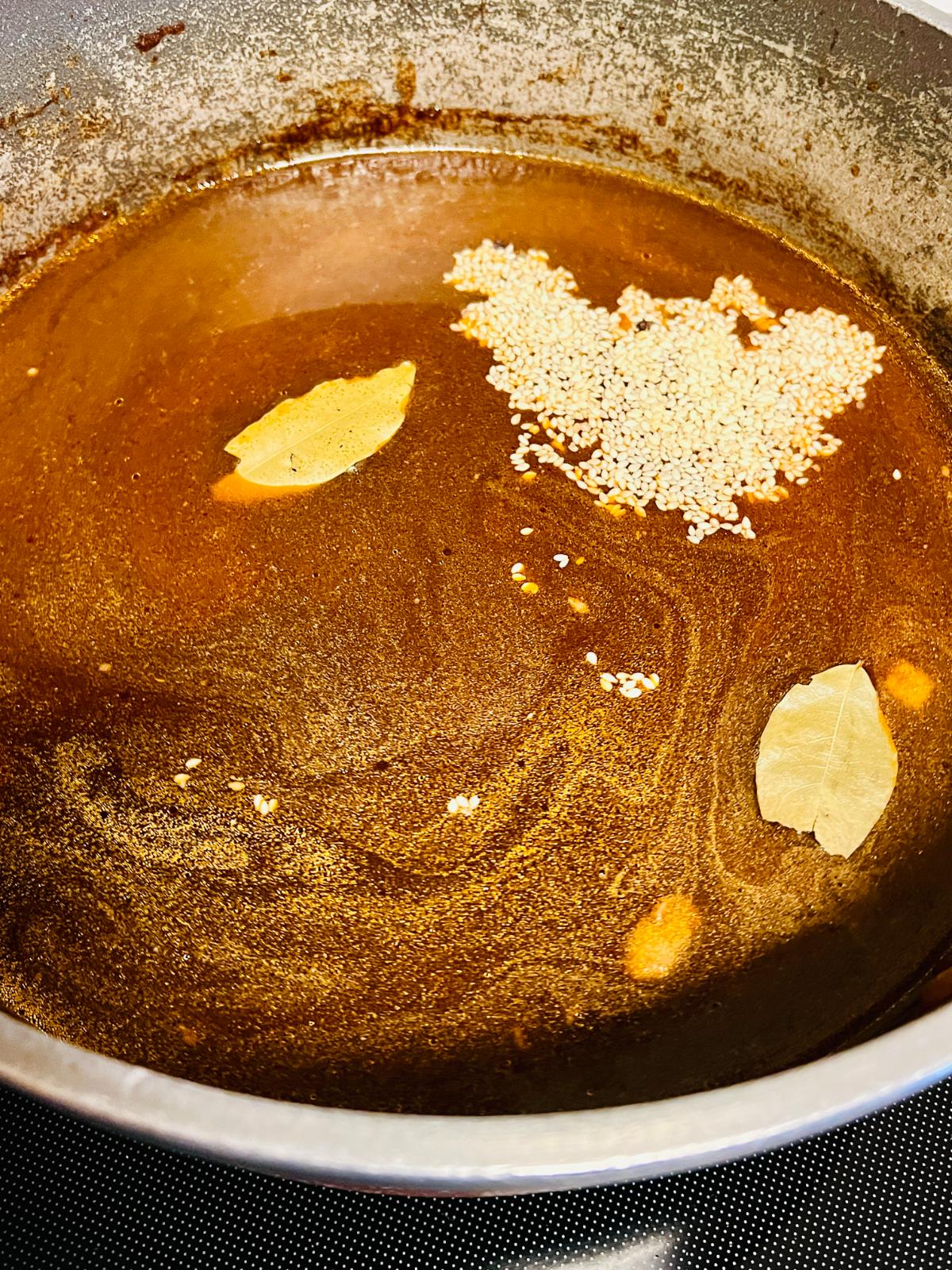
Step 8: Add the Beef
Next, add the browned beef and all the remaining marinade to the broth and mix.
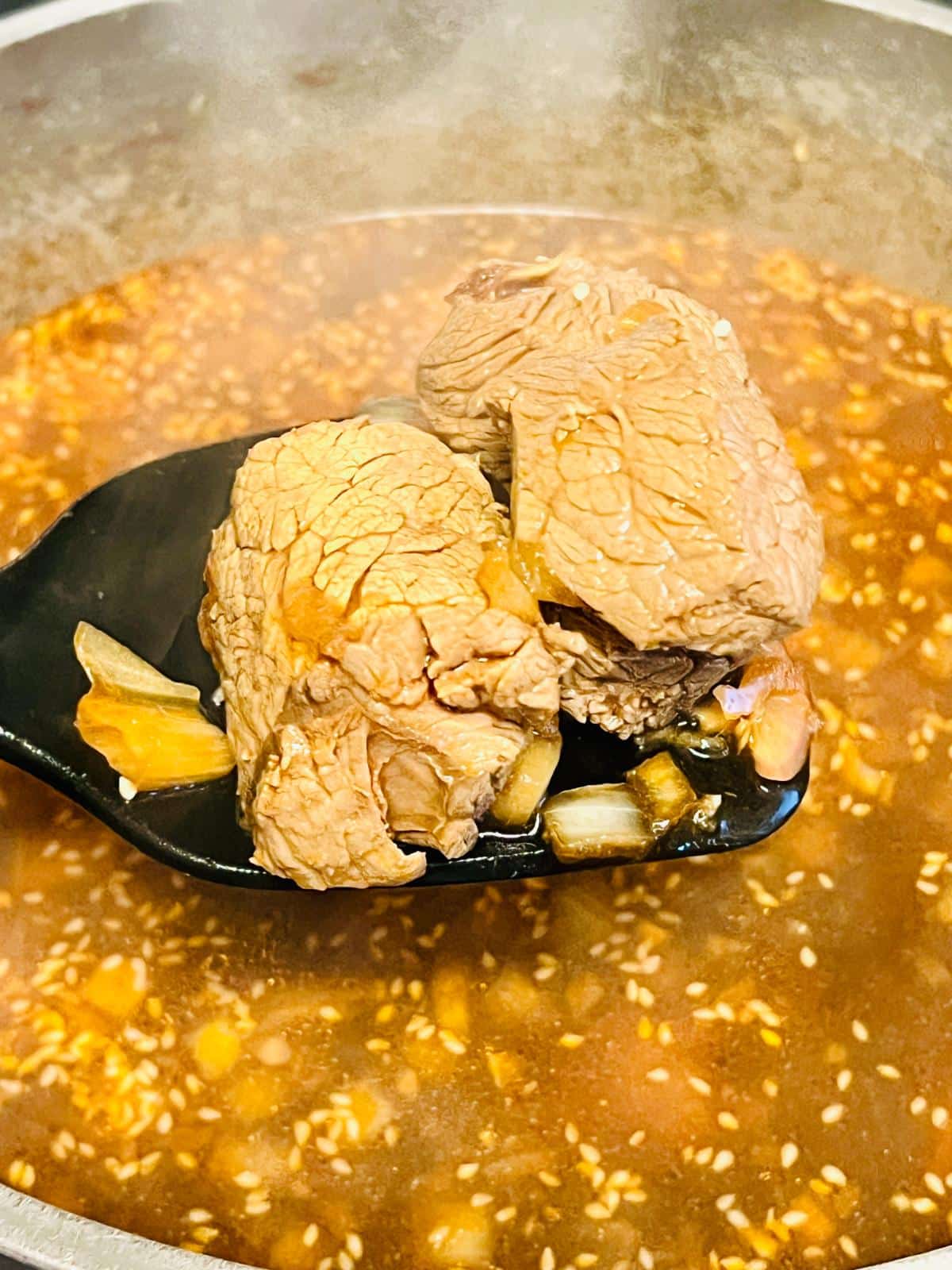
Step 9: Simmer the Stew
Bring the stew to a gentle simmer, cover the pot and cook until the meat is tender. This will take about one to two hours if you’re using boneless beef, or two to three hours if you’re using bone-in beef.
Step 10: Add Vegetables (Optional)
If desired, you can add the daikon and/or other vegetables of your choice to the stew during the last 30 minutes of cooking.
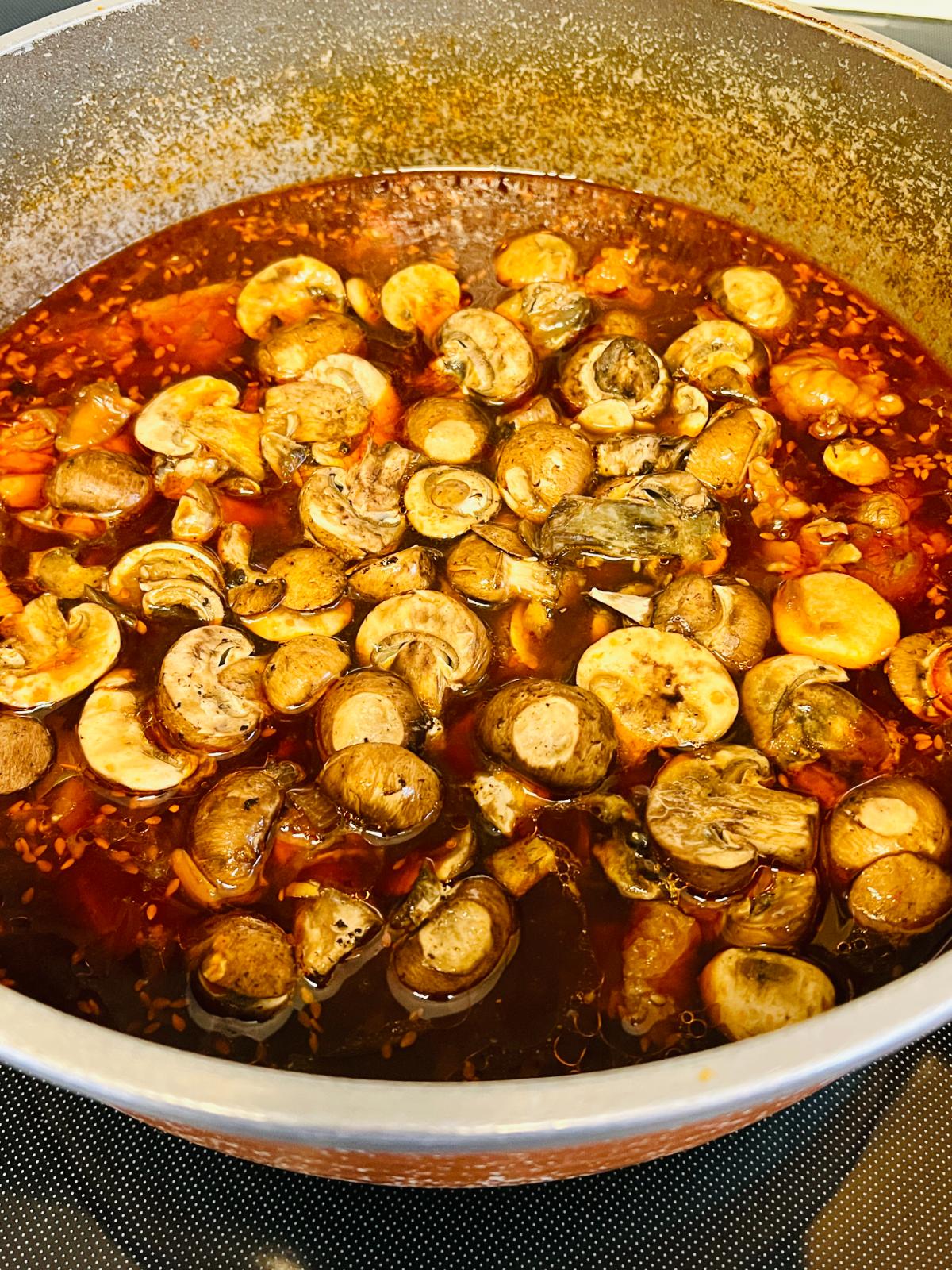
Step 11: Add Seasonings
Taste the stew and adjust seasonings if necessary.
Step 12: Serve and Enjoy
Garnish the dish with chopped spring onions and sesame seeds. Add a bit of sesame oil too. Serve with rice or noodles and enjoy.
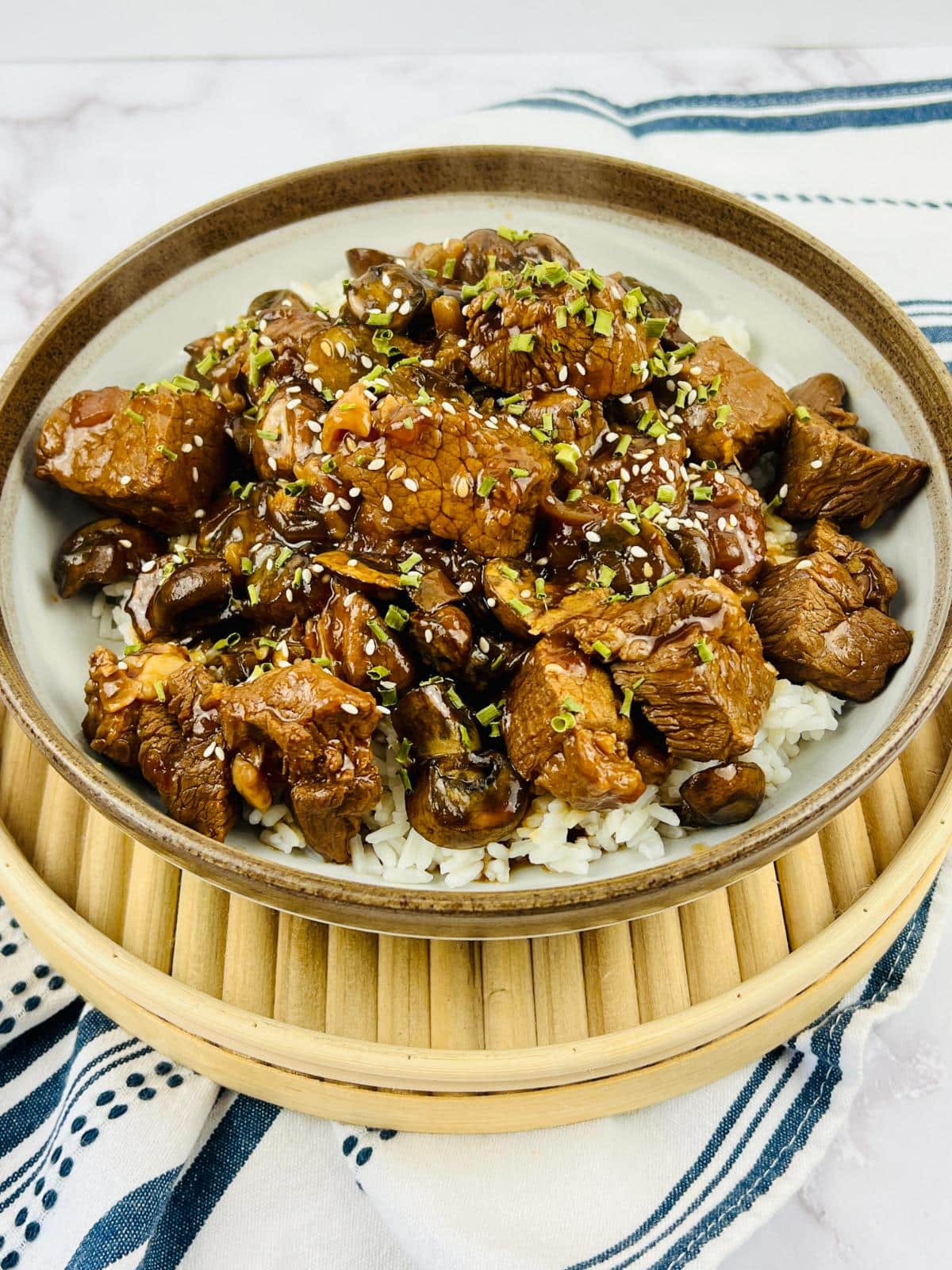
👩🍳 Pro Tips
Keep the following tips in mind to help you make this Korean beef recipe like a pro:
- To make a richer stew, use bone-in short ribs. The bones will add extra flavor and depth to the broth.
- When buying meat, go for well-marbled beef. The marbling contributes to the richness of the stew.
- You can use a combination of light and dark soy sauce for a well-balanced taste.
❓ Recipe FAQs
Yes, you absolutely can. Simply put the marinated and browned beef and vegetables into the Instant Pot and set it to Pressure Cook. Leave it for at least 35 minutes or a bit more if needed.
Any leftover stew can be stored in an airtight container for use later. You can keep it either in the fridge or freezer.
Once the leftover stew is placed in the refrigerator, it can be good for up to three days. On the other hand, if you freeze it, it will stay good for up to three months.
You can reheat the stew either in the microwave or on the stovetop. If you’re reheating frozen stew, however, you can put it in the fridge the day before and then reheat it in the oven until hot.
🙏 Pairing
These are my favorite dishes to pair with Korean beef stew:
Ready to get cooking? Print off the recipe card below or toggle on Cook Mode to keep your screen from going dark while you follow along on your phone or tablet.
SAVE THIS RECIPE!
Enter your email below and I’ll send it straight to your inbox.
📋 Recipe

Korean Beef Stew
Equipment
- Dutch oven or large pot
- Mixing bowl
Ingredients
For the beef:
- 2.2 pounds beef short ribs bone-in or boneless
- 2 tablespoons vegetable oil
- 1 tablespoon Korean pear or apple grated, optional
- 1/2 cup soy sauce
- 1/4 cup gochujang
- 1/4 cup brown sugar
- 2 cloves garlic minced
- 1 inch fresh ginger grated
- 1 onion roughly chopped
- 1/2 cup Korean radish or daikon peeled and cut into thick matchsticks, optional
For the broth:
- 6 cups beef broth
- 1 cup water
- 1 tablespoon sesame seeds toasted
- 10 black peppercorns
- 1 bay leaf
Instructions
- Prepare the beef by patting it dry with paper towels. If using bone-in short ribs, cut them into bite-sized pieces.2.2 pounds beef short ribs
- Prepare the marinade by adding the grated pear/apple (if using), soy sauce, gochujang, brown sugar, garlic, ginger and onion in a large bowl.1 tablespoon Korean pear or apple, 1/2 cup soy sauce, 1/4 cup gochujang, 1/4 cup brown sugar, 2 cloves garlic, 1 inch fresh ginger, 1 onion
- Mix all the ingredients well.
- Add the beef to the bowl.
- Mix the beef with the marinade. Marinate for at least 30 minutes or up to overnight to infuse the beef with deeper flavors.
- Heat the vegetable oil in a large Dutch oven or heavy-bottomed pot over medium heat. Then, take the marinated beef and sear it in batches. Set aside.2 tablespoons vegetable oil
- In the same pot, combine the beef broth, water, toasted sesame seeds, black peppercorns and bay leaf. Bring the broth to a boil, then reduce heat to simmer.6 cups beef broth, 1 cup water, 1 tablespoon sesame seeds, 10 black peppercorns, 1 bay leaf
- Add the browned beef and all the remaining marinade to the broth and mix.
- Bring the stew to a gentle simmer, cover the pot and cook until the meat is tender. This will take about one to two hours if you’re using boneless beef, or two to three hours if you’re using bone-in beef.
- If desired, you can add daikon and/or other vegetables to the stew during the last 30 minutes of cooking.1/2 cup Korean radish or daikon
- Taste the stew and adjust seasonings if necessary.
- Garnish the dish with chopped spring onions, sesame seeds, and sesame oil. Serve with rice or noodles and enjoy.
Notes
Pro Tips
- To make a richer stew, use bone-in short ribs. The bones will add extra flavor and depth to the broth.
- When buying meat, go for well-marbled beef. The marbling contributes to the richness of the stew.
- You can use a combination of light and dark soy sauce for a well-balanced taste.

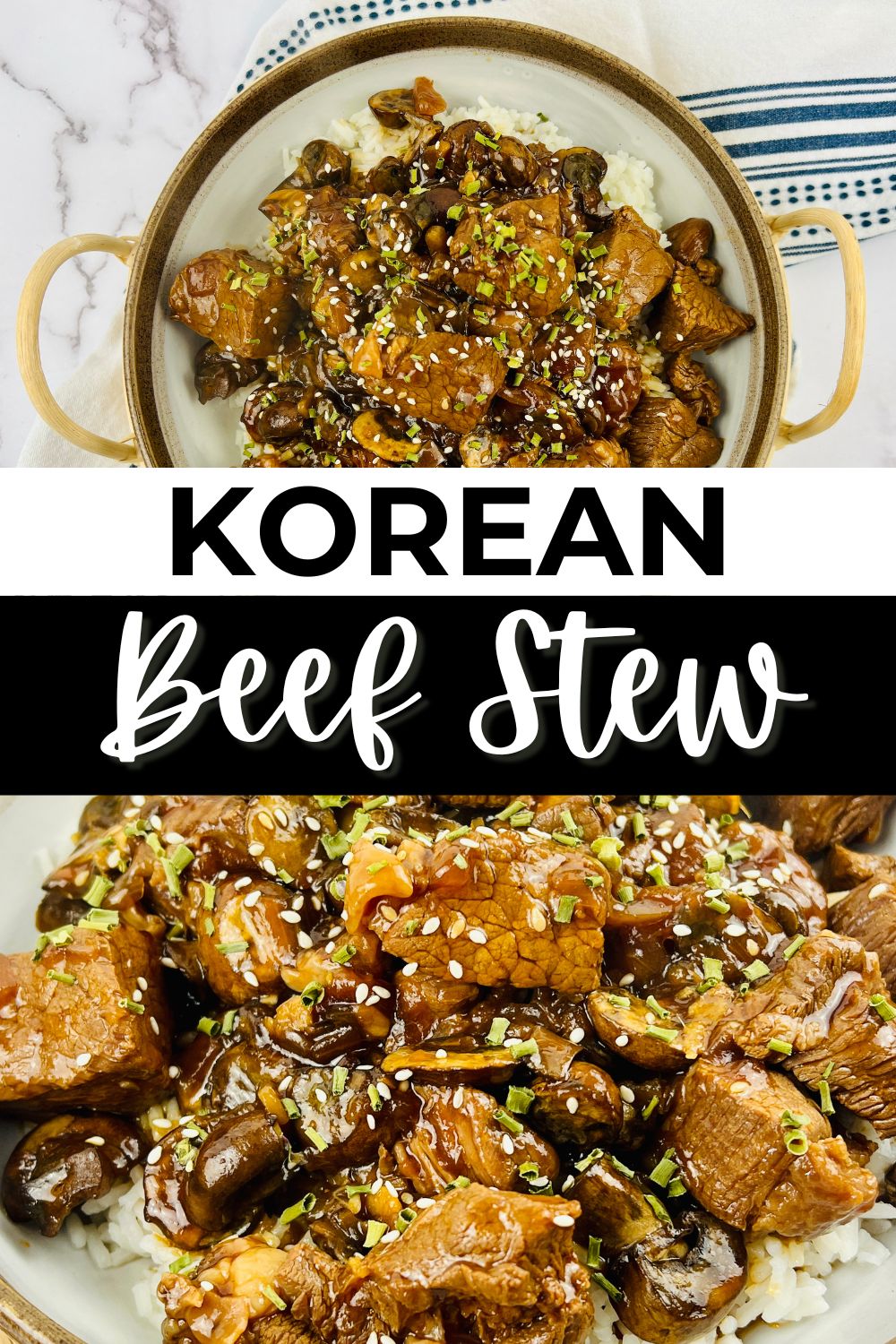
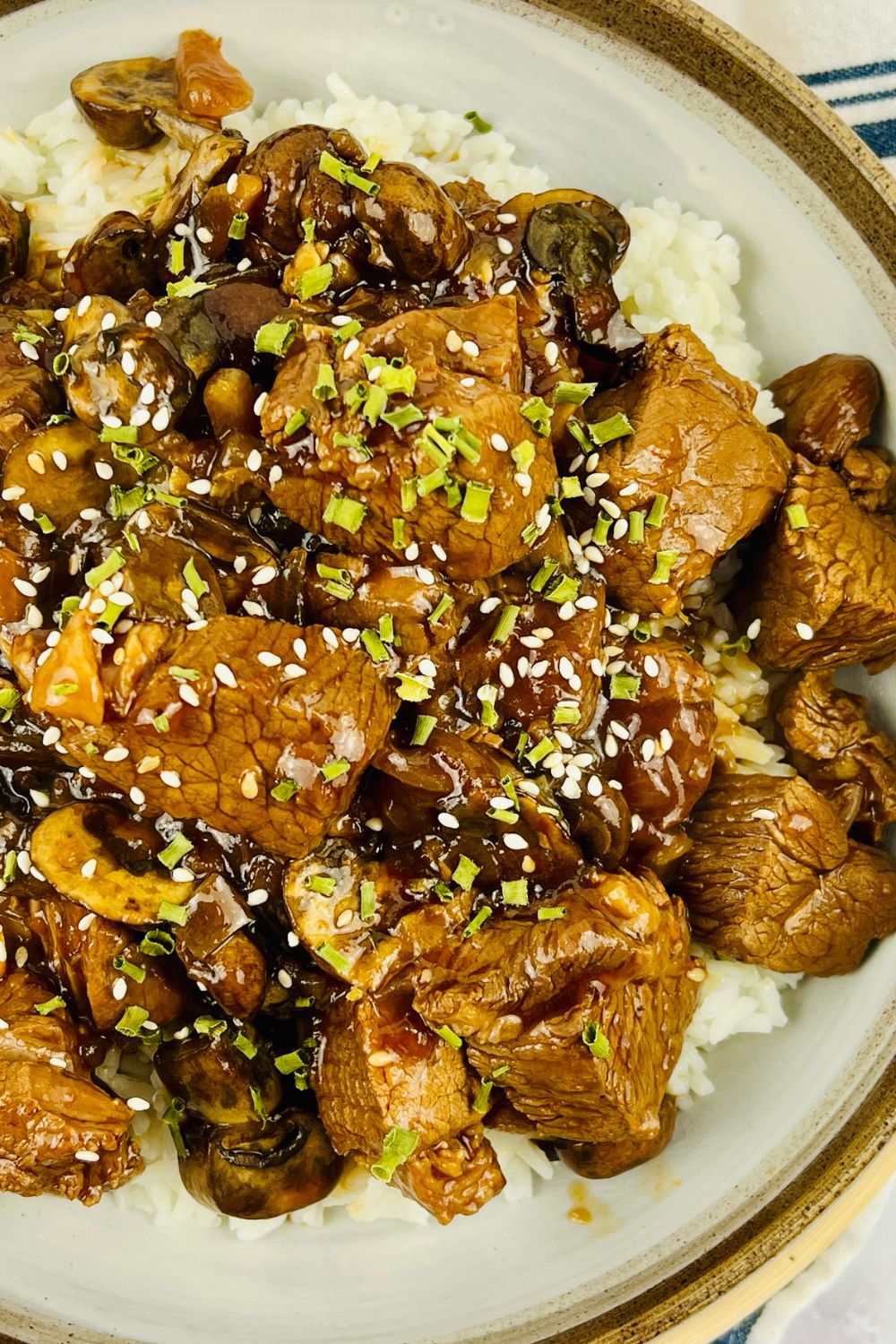
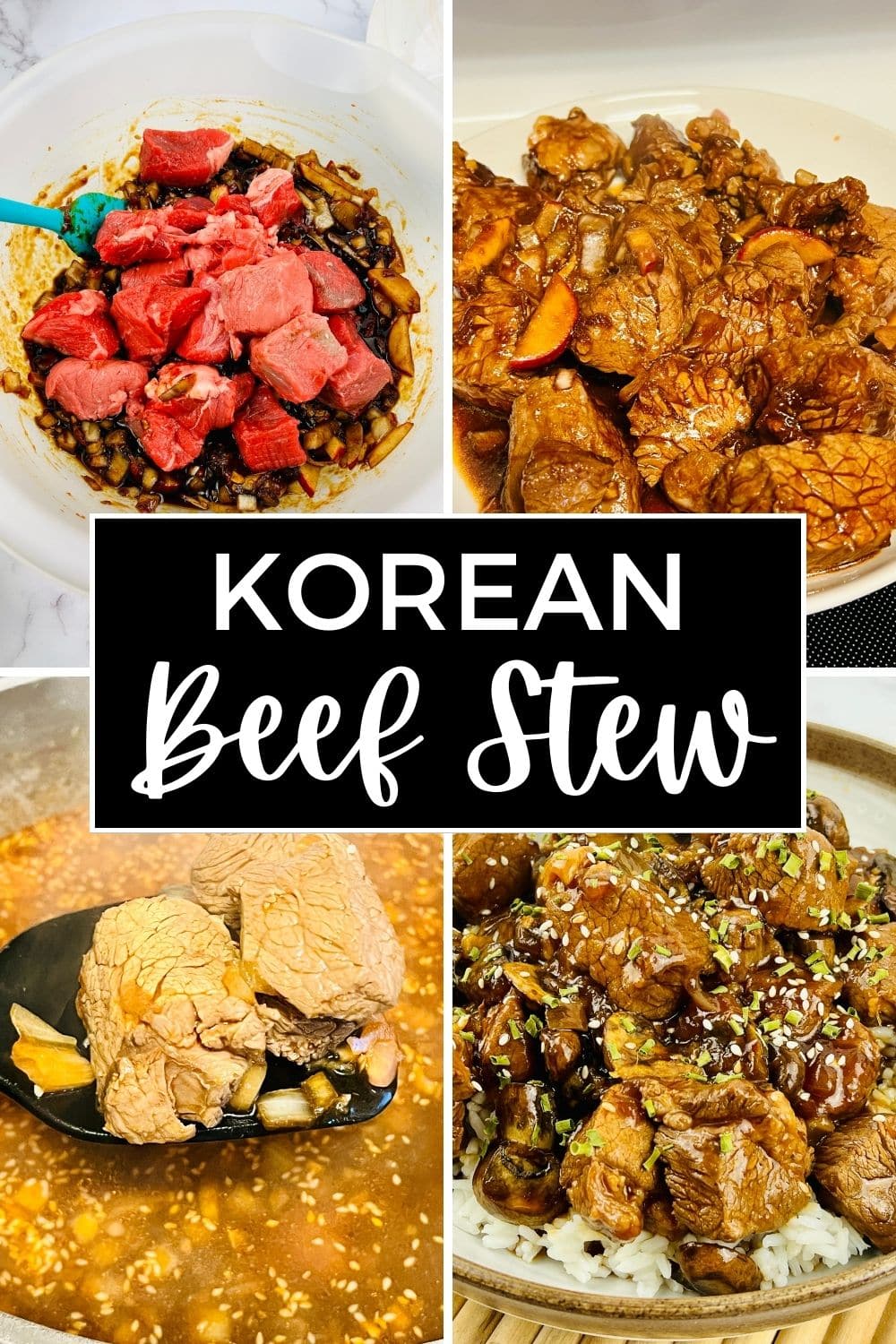
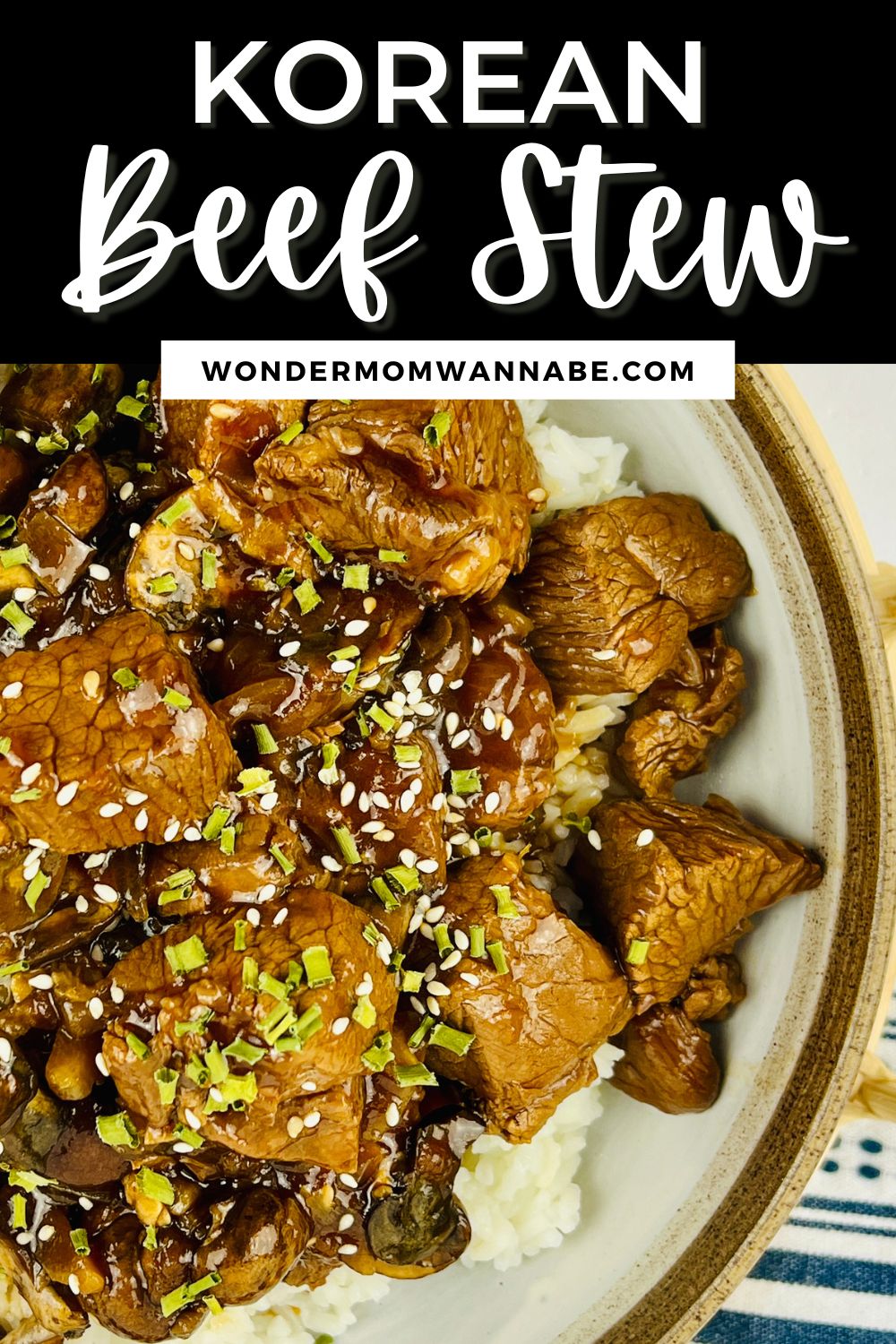

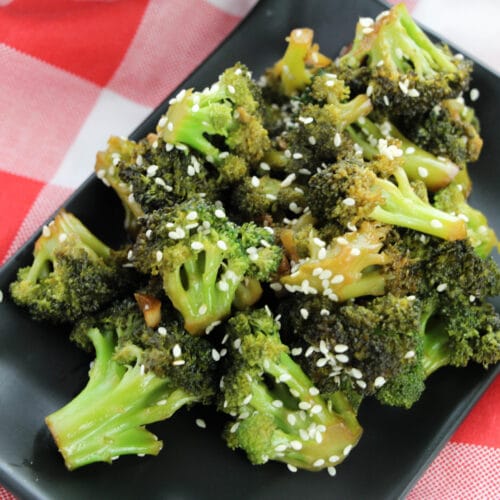

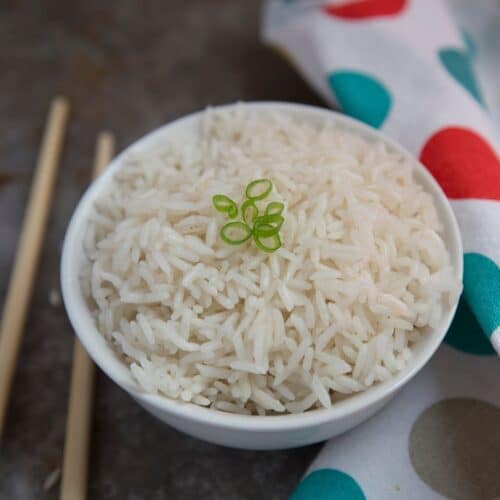
I’ve never had so much difficulty in trying to just read only the recipe!
Hi Louisa, if you can provide more details, I’m happy to help troubleshoot whatever the issue was. The print recipe button opens up a distraction-free version. Also, I have an ad-free membership available if it was ads-related. You can learn more here: https://wondermomwannabe.com/wonder-mom-premium/